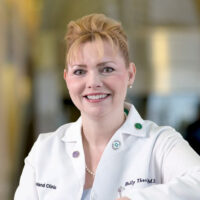Are Breast Cancers Being Over-Diagnosed? Do YOU Need a Mammogram?

By: Holly L. Thacker, MD • Posted on November 27, 2012
The Iconic Breast Cancer Pink Ribbon

Pink ribbons. Hope, strength, and femininity are all part of the iconic pink ribbon, which symbolizes the good fight against breast cancer. We all know someone, near and dear to us, that has had to deal with breast cancer. A woman's lifetime risk of being diagnosed with breast cancer is 1 in 8 or 12.5%.
A woman's breast symbolizes her femaleness, her sensuality, as well as her physical capacity to nurture a baby. There is so much emotion about the breast, the threat of breast cancer and the effects of breast cancer treatment.
Thankfully, gone are the days of the radical and disfiguring mastectomy. One of the Cleveland Clinic's early leaders, Dr. Barney Crile pioneered less invasive treatment for women. Everyday, we are learning more about the genetics of cancer and how to better treat cancer.
Breast Cancer Screening
We need to separate some of this important passion about the breast and look at the science of breast cancer and breast cancer screening. I remember in medical school, my anatomy professor somewhat bluntly and crudely stated, "What is the big deal about breasts? They are just large, modified sweat glands!" Well, there is much more to the breasts than just the incredible ability to secrete the rich, protective colostrum and then a mother's milk.
The breasts ducts are potentially susceptible to abnormal cell growth that can lead to cancer, which may or may not threaten a woman's life. Most women inaccurately rate their risk of dying from breast cancer as higher than dying from cardiovascular disease!
Women should get annual mammograms starting at age 45 and the mammograms should be personalized for each woman. Some women can wait until age 50 to begin screening mammograms and have them done every 2 years. High risk women need more intensive screening.
Over-Diagnosing Breast Cancer
A recent 30-year study was published in the New England Journal of Medicine that estimated that up to one third of women diagnosed with breast cancer have indolent, non-active cancers. During the period of the study, potentially more than one million women were estimated to have been overdiagnosed with breast cancer, that is diagnosed with a tumor that is not destined to progress to any significant problem.
Of course, early diagnosis has been promoted as a way to reduce death rates from breast cancer. However, some of the reduction in breast cancer death is actually due to improvements in treating breast cancer as opposed to solely finding the cancer earlier. The mammogram does NOT pick up all types of breast cancers and some aggressive, fast growing breast cancers are unfortunately not affected by screening mammography, which remains an imperfect, but an important tool.
There are risks with overscreening that can lead to the following:
- Additional biopsies
- Anxiety
- Additional testing
Reduce your risk for breast cancer,
It is important to understand what is in your control to reduce your risk of breast cancer:
- Healthy eating
- Daily exercise
- Avoidance of weight gain
- Not smoking
- Not drinking too much alcohol-no more than 3-5 drinks per week and be sure to get folate and vitamin D3 daily to help with cellular repair and immune function
- Breastfeeding
It is critical to know your family history of cancer as well as to understand the benefits and the limitations of mammography as well as other tools available to assess risk of breast cancer. The Gail Model Risk Assessment Tool as well as formal genetic testing for high risk women and in select women a breast MRI are all important tools. We have two FDA approved medications to reduce breast cancer diagnosis for those women at high risk:
- Tamoxifen-FDA approved to reduce pre- and postmenopausal ER positive breast cancer.
- Raloxifene-FDA approved to reduce postmenopausal ER positive breast cancer.
- Trials involving aromatase inhibitors.
BRCA Gene Mutation
Women with the BRCA gene mutation may actually choose a risk-reducing mastectomy with or without reconstruction preventatively and bilateral ovary removal after age 40.
So, what do YOU do? Knowledge is power and one size does not fit all. You need to know that mammograms can catch some cancers that might never make you ill and that conversely some cancers will not be caught by mammograms. However, you should NOT use this as an excuse to avoid breast screenings. Rather, with your women's health physician, you should assess your risk for breast cancer, your tolerance for false positive tests, and when and how often you should be screened.
For more information on breast cancer, download our free Breast Cancer Treatment Guide.
Be strong. Be Healthy. Be in Charge!
Yours truly, in pink,
-Dr. Holly L. Thacker MD FACP CCD NCMP
Holly L. Thacker, MD, FACP is nationally known for her leadership in women’s health. She is the founder of the Cleveland Clinic Women’s Health Fellowship and is currently the Professor and Director of the Center for Specialized Women’s Health at Cleveland Clinic and Lerner College of Medicine at Case Western Reserve University. Dr. Thacker is also the Executive Director of Speaking of Women’s Health and the author of The Cleveland Clinic Guide to Menopause. Her special interests and areas of research include menopause and related medical problems including osteoporosis, hormone therapy, breast cancer risk assessment, menstrual disorders, female sexual dysfunction and interdisciplinary women’s health.
breast, breast cancer, breast cancer awareness, breast cancer overscreening, cancer, mammogram, screening mammography, women's health
Related Articles
- Ask the Expert: Breast Cancer Risk Factors, Am I at Risk?
- Ask the Expert: How can I Minimize my Risk of Breast Cancer?
